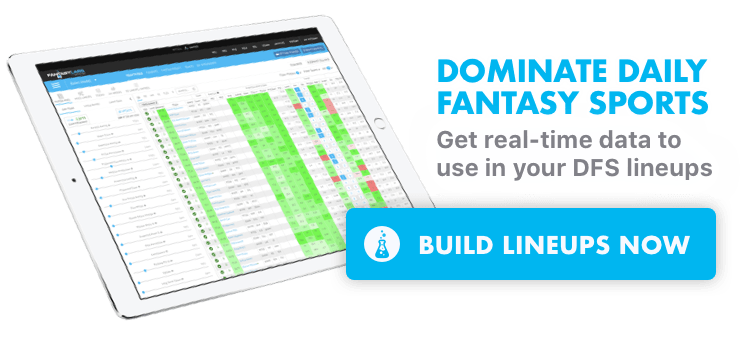In the weekly Fantasy Trends, we leverage the Trends tool to find quarterbacks, wide receivers and running backs with notable data points for the upcoming main slate. For more of our weekly football content, visit our NFL homepage.
This offseason, I analyzed historical running back trends dating back to 2002. After controlling for population sizes from season to season, the correlation between opportunity and fantasy performance yielded an R-squared value of .80, meaning that 80% of running back fantasy production is explained by opportunity alone.
Since this relationship is so strong, it behooves us to evaluate running back workloads entering Week 7. Thankfully, Action Network editor/writer/analyst/renaissance man Bryan Mears has been updating Fantasy Football Workload Data each week, giving us plenty of data to draw our analysis from.
So, I compiled data on running back snaps and opportunity statistics and broke down our running back sample into quartiles. Quartiles separate a sample population into four equal groups. In our case, those four quartiles are separated based on percentile rank rather than raw number of individuals. I then evaluated the performance of each running back quartile using our Trends tool.
Full Results
Below are per-game stats and percentile ranks for all running backs with at least 5.0 snaps per game through Week 6:
Before we dig in, it’s important to recognize that the baseline Plus/Minus for all running backs in our sample is +0.88. So, for example, if a quartile reports a Plus/Minus of +0.50, that result is actually low for running backs this season. Even if you see a positive Plus/Minus split for a given quartile in our analysis, you should compare that result to a +0.88 standard. Accordingly, I’ve reported control statistics in each table to reinforce that standard for our discussion.
Opportunities per Game
As expected, running backs who have earned the most opportunities (rushes plus pass targets) this season have dominated the fantasy sphere.
Upper 25th-percentile performers boast the highest average Actual Points and a staggering Plus/Minus of +3.95. However, they also feature by far the highest Ownership at 11.2%. These are the Todd Gurleys and Alvin Kamaras of the fantasy world. It’s expected that they would deliver the most fantasy points on average. It’s perhaps unexpected that they are also delivering by far the best bang for your buck.
Lower 25th-percentile performers, by contrast, have been absolutely dreadful to start 2018. They feature a -2.75 Plus/Minus and deplorable Consistency. Accordingly, they are by far the least-owned quartile in our analysis at 0.3% Ownership.
This preliminary analysis suggests that stacking highly priced running backs is far more cost-efficient than seeking value in the bargain bin. Long live Team Jam ‘Em In.
Snaps per Game
Once again, we can see that running backs who earn the most snaps are clearly more valuable than running backs who earn less. This finding makes sense, of course, because snap count should be highly correlated to on-field opportunity.
Interestingly, however, we observe no discernible difference in Plus/Minus between the 75th and 50th quartiles among running backs. Both groups boast similar Plus/Minus scores and Consistency ratings.
So, what’s going on here?
My speculation is that beyond the top 25th-percentile of running backs, workload matters far more than raw snap total. Certain running backs might see the field for a variety of reasons: To run the ball, to pass block, to release on routes as a receiver, etc. If a running back is seeing the field plenty but does not see ample opportunity when on the field, his snaps are largely irrelevant for fantasy production.
Targeting Value Running Backs Using Workload Data
To examine this further, I isolated a specific group of running backs to test my hypothesis: Our sample to running backs whose snaps per game fell between the 25th- and 75th-percentile, thereby capturing the two quartiles referenced above with similar Plus/Minus scores. Then, I added a second filter: Among the running backs remaining, I further isolated only running backs who rank above the 50th-percentile in opportunities per game.
By applying these filters, I am effectively highlighting running backs who see the field a moderate amount but who command an above-average market share of touches when they are on the field.
As you can see in the results above, these running backs boast a Plus/Minus of +2.00, which is markedly higher than either of our source populations. These running backs offer significant fantasy value at relatively low Ownership (4.5%).
Consider targeting the following players when optimizing your DFS lineups for Week 7, contingent on each running back’s health and availability:
News Updates
After this piece is published, FantasyLabs is likely to provide news updates on a number of players mentioned here. Be sure to stay ahead of your competition with our NFL news feed.
Photo Credit: Stew Milne-USA TODAY Sports
Pictured Above: James White






